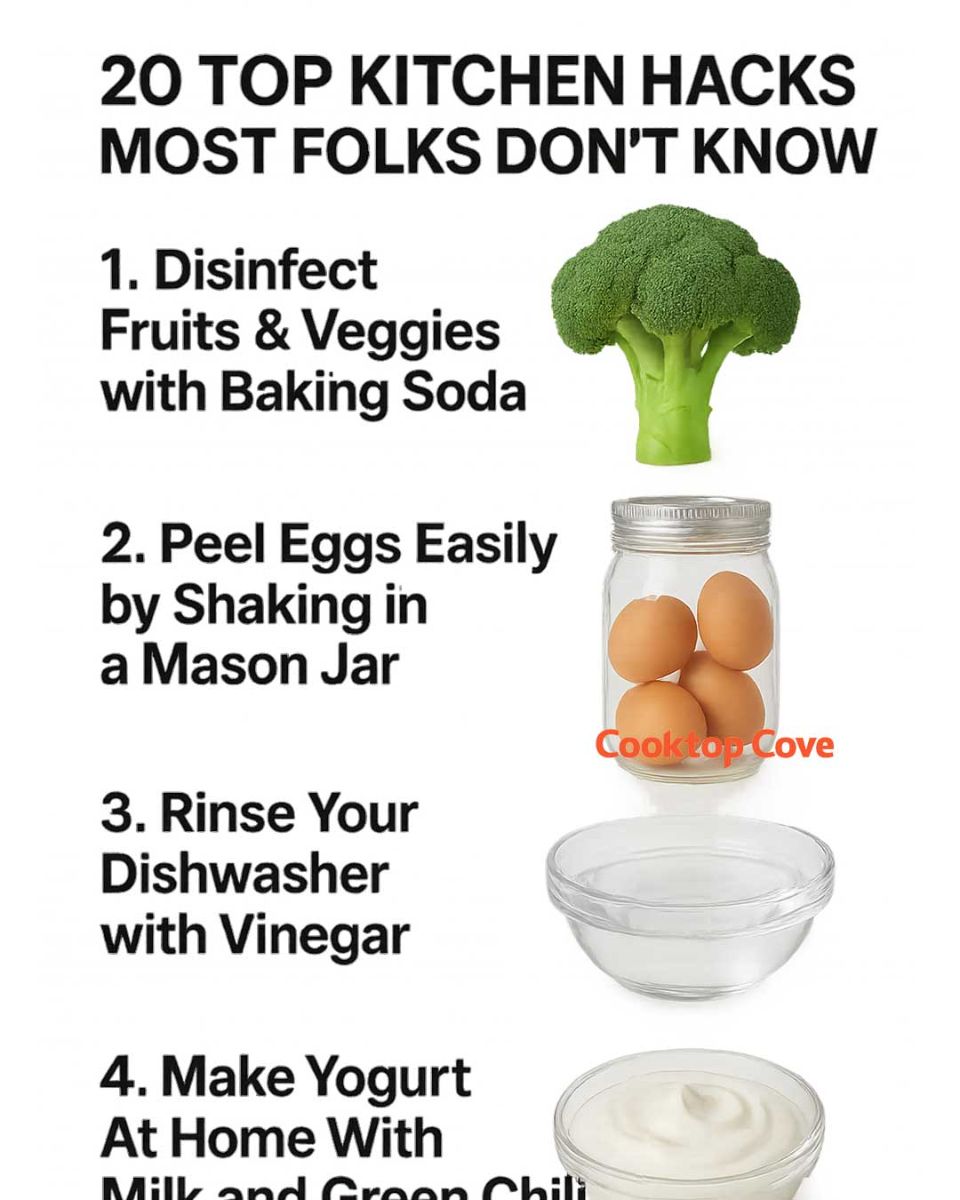ADVERTISEMENT
1. Disinfect Fruits & Veggies with Baking Soda
How: Fill a large bowl with water and add 1–2 teaspoons of baking soda. Soak produce for 10–15 minutes, scrub gently, then rinse.
Why: Baking soda neutralizes pesticides and bacteria better than water alone, leaving produce cleaner and safer.
2. Peel Eggs Easily by Shaking in a Mason Jar
How: Place a boiled egg in a mason jar, fill with a little water, seal, and shake gently for 5–10 seconds.
Why: The agitation cracks the shell all over, making it slide off effortlessly.
3. Rinse Your Dishwasher with Vinegar
How: Pour 1 cup of white vinegar into a dishwasher-safe bowl on the top rack and run a hot cycle (empty machine).
Why: Vinegar removes mineral buildup and odors, improving performance and freshness.
4. Keep Herbs Fresh with a Damp Paper Towel
How: Wrap herbs in a slightly damp paper towel and store in a resealable bag or container in the fridge.
Why: Prevents wilting and extends life for up to a week longer.
5. Instantly Ripen Bananas in the Oven
How: Place unpeeled bananas on a baking sheet. Bake at 300°F (150°C) for 15–30 minutes, until blackened.
Why: The heat rapidly converts starches to sugars, perfect for baking.
6. Freeze Leftover Wine for Cooking
How: Pour wine into ice cube trays and freeze. Store cubes in a zip-top bag for easy use.
Why: Great for deglazing pans, making sauces, or risotto—no wasted wine!
7. Prevent Boil-Overs with a Wooden Spoon
How: Lay a wooden spoon across the top of a boiling pot.
Why: The wood breaks the surface tension, stopping foam from spilling over.
8. Grate Cold Butter for Baking
How: Use a box grater to shred cold or frozen butter before adding to flour.
Why: Distributes butter evenly, producing flakier pastry, biscuits, and scones.
9. Peel Ginger with a Spoon
How: Scrape the edge of a metal spoon along ginger root to remove skin.
Why: It’s safer, faster, and wastes less than a knife or peeler.
10. Regrow Green Onions in Water
How: Place white roots of used green onions in a glass with enough water to cover roots. Put on windowsill; change water every few days.
Why: Green tops regrow in days for continuous, free supply.
11. Use a Potato to Remove Excess Salt
How: Drop a peeled, raw potato into an over-salted soup or stew, simmer for 15–20 minutes, then remove.
Why: Potato absorbs some salt, reducing overall salinity.
12. Slice Cherry Tomatoes with Two Plates
How: Place tomatoes between two plates (one right-side up, one upside-down) and slice horizontally with a sharp knife.
Why: Halves dozens of tomatoes in seconds, safely and evenly.
13. Keep Brown Sugar Soft with Bread
How: Add a slice of bread (or apple) to the sugar container.
Why: Moisture from bread keeps sugar from hardening; replace as bread dries out.
14. Remove Corn Silk with a Damp Paper Towel
How: After husking, gently rub corn with a damp paper towel.
Why: Silks stick to the towel, making cobs clean and ready.
15. De-crystallize Honey in a Warm Water Bath
How: Place honey jar (lid off) in a bowl of hot (not boiling) water for 10–15 minutes.
Why: Gently dissolves crystals, returning honey to liquid form.
16. Use Parchment Paper to Stop Cake Sticking
How: Trace cake pan on parchment paper, cut to fit, and line pan bottom before adding batter.
Why: Ensures easy release without sticking, perfect for layered cakes.
17. Soften Browned Avocado with Lemon Water
How: Submerge cut avocado in cold water with a tablespoon of lemon juice.
Why: Reduces browning and keeps avocado fresher longer.
18. Peel Garlic Cloves by Shaking in a Bowl
How: Place garlic cloves between two metal bowls (inverted), shake vigorously for 20 seconds.
Why: Skins loosen and fall off, speeding up prep.
19. Shred Chicken Quickly with a Hand Mixer
How:
ADVERTISEMENT
